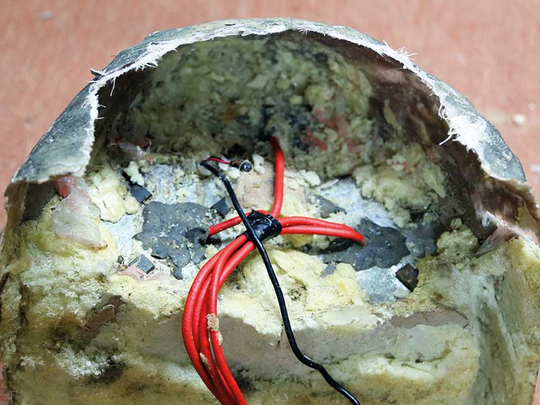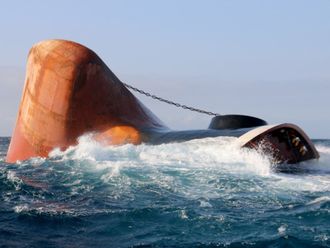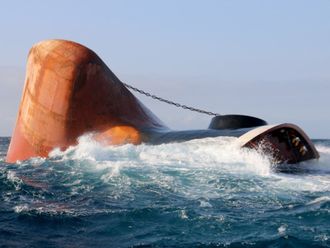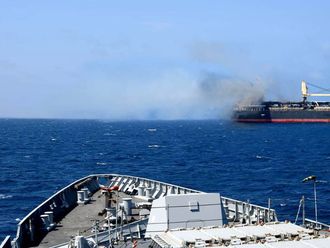
Dubai: Roadside bombs disguised as rocks in Yemen bear similarities to others used by Hezbollah in southern Lebanon and by insurgents in Iraq and Bahrain, suggesting at the least an Iranian influence in their manufacture, a watchdog group said on Monday.
The report by Conflict Armament Research comes as the West and United Nations researchers accuse Iran of supplying arms to Yemen’s Iran-backed Al Houthi militia, which has held the country’s capital since September 2014.
Those weapons allegedly included ballistic missiles used to target Saudi Arabia, which leads a military coalition of Arab nations against Al Houthis. A barrage of Al Houthi missile fire late on Sunday killed one person in the Saudi capital, Riyadh, and wounded two others.
“What we’re hoping this does is make plausible deniability not very plausible,” said Tim Michetti, head of regional operations for Conflict Armament Research. “You can’t really deny this anymore once the components these things are made with are traced to Iranian distributors.”
Michetti’s organisation said it examined a fake rock bomb in January near Mokha, some 250km southwest of the capital, Sana’a.
The fiberglass-encased bomb, packed with explosives, could be armed by radio and triggered by an infrared beam, the group said. It said there were three varieties, including anti-personnel mines and so-called explosively formed projectiles, which can penetrate armored vehicles and were used with lethal effect against US troops following the 2003 invasion of Iraq.
Electrical circuitry in the bombs mirrored those manufactured by militants in Bahrain, while the bombs bore markings suggesting one workshop mass-produced the explosives, the report said. Such bombs, however, have yet to be used in Bahrain, an island kingdom off Saudi Arabia in the midst of a crackdown on all dissent.
Investigators also found a type of Chinese-manufactured wire covering used in other Iranian materiel, the report said.
It said independent experts also examined the explosives. Those experts said that “construction indicates that the bomb maker had a degree of knowledge in constructing devices that resembled, and possibly functioned in a manner similar to (explosively formed projectile bombs) that have been forensically tied to Iran and Hezbollah,” the report said.
This is not the first time Iran has been accused of arming Al Houthis.
The US Navy’s 5th Fleet, based in Bahrain, has repeatedly said Iran sends arms into Yemen. It points to seizures over a four-week period in early 2016, when coalition warships stopped three dhows, traditional ships that ferry cargo in the Gulf. The dhows carried thousands of Kalashnikov assault rifles as well as sniper rifles, machine guns, rocket-propelled grenade launchers, anti-tank missiles and other weapons.
One dhow carried 2,000 new assault rifles with serial numbers in sequential order, suggesting they came from a national stockpile, a previous Conflict Armament Research report said. The rocket-propelled grenade launchers also bore hallmarks of being manufactured in Iran, the group said.
The group has also said drones used by Al Houthis to crash into Patriot missile batteries in Saudi Arabia share “near-identical design and construction characteristics” of Iranian drones.
The weapons transfers also allegedly include ballistic missile technology. The United Nations, Western countries and the Saudi-led coalition fighting in Yemen all say Al Houthis’ Burkan or Volcano missile mirrors characteristics of an Iranian Qiam ballistic missile. They say that suggests Tehran either shared the technology or smuggled disassembled missiles to the Houthis who then rebuilt them.
Iran denies sharing missiles with Al Houthis, though such a move would fit a pattern followed by the Islamic Republic since its 1980s war with Iraq. Iran largely has avoided direct confrontation with its foreign adversaries, instead relying on proxy groups that it arms through the hard-line Revolutionary Guard’s expeditionary Quds Force or other middlemen.
Iran’s weapons transfers to Yemen bleed Saudi Arabia, its regional rival, at a low cost while providing deniability for Tehran, analysts say.












